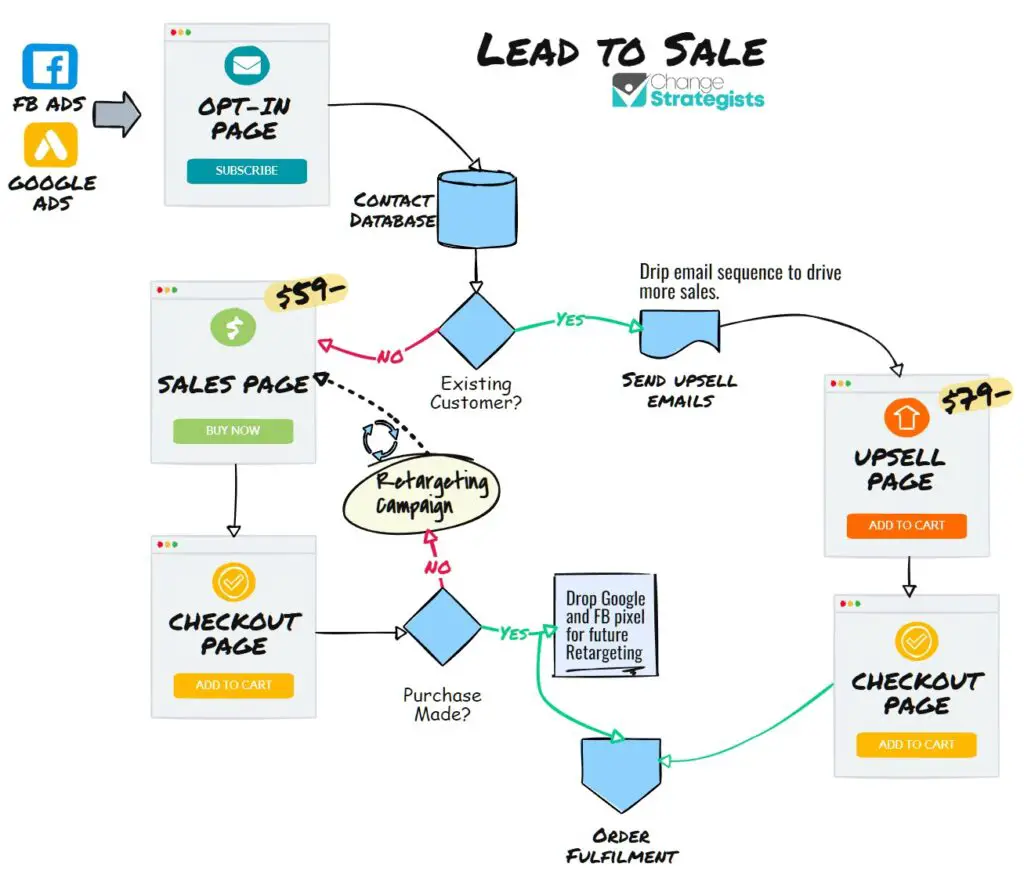Standardizing processes is the ultimate goal of almost every organization, big or small. When everyone works in their own way – the chances of costs soaring and errors being made are higher than ever. This is where the development of end-to-end processes comes in. So what do we mean by an end-to-end process?
An end-to-end process is a complete process of achieving an objective from start to finish without the involvement of a third party. An example of this can be the entire process from when a customer purchases on a business’s website to when the product is delivered to the customer.
Businesses have realized the importance of having end-to-end processes over the last four years. The pandemic fortified this need even further, exposing loopholes in existing business processes and structures.
Let’s look at some examples of end-to-end processes that are most commonly used in businesses.
Three Main Categories of a Business Processes
A business process is a set of actions and procedures designed to achieve an objective or carry out an important business activity.
There are three main categories in which most business processes fall:
- Core processes
- Support processes
- Management processes
Each of these are vital, but in different ways.
Core Processes
A core process is directly linked to increasing value for customers of a business and ensuring revenue growth. These processes span different departments and functions and add value for the end-user.
A great example of this is the procurement to payment process, which I’ll cover later on.
Core processes should be prioritized above others as they have a direct impact on the revenue and the customer relationships for a business.
Support Processes
As the name suggests, support processes exist to enable the execution of the core processes. These processes don’t impact income directly. However, they ensure support for existing customers and that things are done on time.
A good example of this can be the hire to retirement process, where HR is never directly involved in developing a service or product. Instead, they support development by providing the right resources to do the job and retaining or replacing them when necessary.
Management Processes
What manages the core and support processes? The management processes. They are designed to develop, control, measure, and change these processes. Management processes ensure the business is running smoothly and efficiently.
Management processes ensure no threats to the business, and everything from concept to execution is running well. A good example of this is the financial planning to execution process, which ensures the business and its initiatives stay on budget.
Examples of End to End Business Processes
End-to-end business processes are usually utilized in information technology scenarios, but there are some other prominent business areas where they can be applied.
Here are a few examples:
Lead to Sale
One reason why enterprise resource planning software has gained popularity within business is their ability to automate and handle the entire journey of a prospect being a mere lead to a full-blown sale.
This end-to-end process allows a business to automate every step required to convert a prospect to a sale.

This end-to-end process allows storing contact information and building custom marketing workflows that include automatically sent marketing emails, text messages or scheduled sales calls to help reiterate the company message and offer.
Problem to Resolution
This one can apply to both internal operations and customer services. For internal operations, this can mean an end-to-end process for identifying problems within the organization and resolving them.
When it comes to customer services, it means having a proper process for receiving customer feedback and complaints and resolving them till the customer is satisfied and the issue is resolved. It also involves identifying any potential improvement in service or product based on customer feedback.
In some industries, the automation process is used to help identify and flag potentially high level problems faster. For example in the UK telecommunication industry if the customer states they are escalating the problem to the industry regulator the customer account can be automatically flagged to senior advisors ahead of other accounts.
Order to Cash
Order to cash processes are applied in retail environments where the implementing body oversees the entire process from when a customer places an order to packaging, dispatching, and delivering the product.
The implementation of this type of process ensures that customers receive what they ordered as quickly as possible without compromising quality.
Concept to Market
Go-to-market strategies are an excellent example of an end-to-end process. They entail all steps from the conception of a product to taking it to market and promoting it. These processes allow businesses to lay out the steps and individuals involved in product and service development.
There can be a universal process that all the company follow, or sub ones for different categories of products depending on the company’s structure and the niche they operate in.
Procurement to Payment
A procurement process also entails the company that procures products to manage the entire cycle. This includes everything from procuring the items, receiving them, and then ensuring due payments are made on
Financial Planning to Reporting
Every company develops a budget and a financial plan for the year. This end-to-end process ensures all necessary steps are taken to execute the plan and proper reporting on its success rate is done at the end of the year.
Hiring to Retirement
Human Resources departments are vital to the success of an organization. Hiring to retirement processes determines all the necessary steps and stages involved in an employee’s entire employment cycle.
From the moment an employee is onboarded to when they leave the company or retire from it form the steps of this process.

How to Prioritize an End-to-End Process?
With so many business aspects warranting an end-to-end process, how do you, a business or executive, choose which one to develop and execute first?
The answer to this depends on several factors.
- Processes involving customers and their satisfaction should be prioritized amongst others. After all, maintaining healthy customer relationships is essential for business continuity.
- Processes developed to improve internal operations and management can gradually add to the usual way of doing things.
Whichever end-to-end process is being designed or implemented, it is important that it encompasses the entire process and doesn’t leave out any steps or other departments.
- In short, your core processes are vital for the business’s survival, but they cannot be implemented without complementing support and management processes.
Prioritizing process development can be tricky, but a balanced approach can ensure business continuity and a strengthened organization from within.
Why Are End to End Business Processes Vital?
End-to-end processes benefit organizations on multiple levels. They enable organizations to have standard procedures and eliminate chances of errors and missteps. Here are some reasons why end-to-end processes are vital for today’s businesses.
Process efficiency improvement
When you develop end-to-end processes, you meticulously go through each step involved in a business process. This allows you to see loopholes and inefficiencies in processes and procedures and improve operations.
Reduce operating costs
Reviewing processes in detail lets you understand which steps and activities are counterproductive for your business. So, you can remove these steps and actions to save time and money associated with them.
Mitigate errors
When everyone in the organization follows set standards of operation, the chances of errors are reduced significantly. Mitigating errors also reduces the cost of time spent on remedying them.
Increase accountability and compliance
The best thing about set processes is the identification of roles. A set process determines who is responsible for what and helps management see where things go wrong and who is responsible.
Measure effectiveness
When you know how a process should work, you can easily measure its effectiveness. Set KPIs will allow you to see the efficiency levels at which your strategies are performing.
Automate where required
Knowing every step and its nature within a process enables business owners and managers to see which actions can be automated to increase efficiency.
Enable team collaborations
Often, ambiguity in accountability when it comes to tasks can scare employees from collaborating on projects. When it is clear who is responsible for what, employees are more motivated to help each other and collaborate on projects.
Benefits and Limitations of an End to End Business Process
Now that we’ve gone through in detail why it is crucial to have specific end to end processes as part of your business operations, let’s take a glance at the major benefits and limitations you will encounter when implementing these:
| Benefits | Limitations |
| Enhances a company’s competitive advantage and reduces financial costs | Require extensive change management skills and processes in place |
| Creates more transparency and accountability within the organization | Requires presence of a strong information technology infrastructure |
| Promotes revenue growth and innovation within the organization | One owner for implementation may give rise to conflicts over accountability |
| Increases efficiency in project delivery |
Implementing end-to-end processes takes time and requires patience on the entire organization’s part. It requires a good amount of change management skills to ensure everyone in the organization is on board with these processes.
It is also equally important to evaluate these processes to determine their efficiency and see if any changes are required.
Industries That Can Benefit from End to End Processes
There is no limit to what kind of business can implement an end-to-end process. Every business exists to make money and serve clients or customers and therefore every business has workflows that can be viewed through the end-to-end model.
Here is a brief glance at how different industries can use lot to end processes:
Real Estate
The real estate industry can benefit from implementing end-to-end workflows for processes such as tenant management, property management, and selling and buying properties.
Quite a lot of client interaction is involved in all these sub-categories of businesses that can benefit from set workflows and processes.
Healthcare
The healthcare industry is a sensitive business which means all the more need for setting standards and operating procedures to ensure quality services. Healthcare businesses can benefit from automating and implementing processes such as managing patient history and files.
Construction
Construction involves a diverse range of processes as well. From conceptualizing a house, and locking it down with the client to ensuring the result is quality. These processes can benefit from the end-to-end process model and ensure accountability at all levels.
This industry also involves a lot of risk mitigation. When there are set standards and procedures and people are accountable for every step of a project, it is easier to minimize risks. It also allows for knowing who is responsible when a mistake is made.
Marketing
The marketing industry has evolved tenfold over the past decade due to the introduction of digital media and techniques. Many offshoots of marketing can be automated and put into end-to-end processes to ensure efficiency and quick returns on investments.
ERPs are built with marketing needs specifically in mind with marketing automation and campaign delivery processes.
Business Management
While this isn’t an exact industry it is something that’s part of every industry. Business process management is a niche on its own.
This wing of a business ensures it is running smoothly and that all departments are collaborating effectively. Everything from HR. Sales, admin to marketing fall under this category.
Frequently Asked Questions
Why is an end-to-end process important?
End-to-end processes enable companies to introduce more efficiency, improve collaboration and ensure compliance. These processes make an organization receptive to changes and growth opportunities.
What is an end to end business process management?
End-to-end business process management means having a single owner for one specific process in the organization. This process owner has total ownership and accountability when initiating and executing the process they own.
What is an end-to-end analysis?
The end-to-end analysis reviews the interaction between a company and its customers and determines their effectiveness. Analyzing these processes allows businesses to develop strategies and policies to retain existing customers and acquire new ones.
Final Thoughts
End-to-end processes are beneficial and vital for introducing efficiencies and reducing costs in an organization. Examples can be found and replicated for both tech and non-tech processes. Almost every industry out there can benefit from an end to end process. We hope this article helps you determine where your business can implement an end-to-end workflow.




